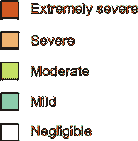
 |
The following map of the atmospheric corrosivity measured in Chile was adapted from "Atmospheric Corrosion of Copper in Ibero-America" by M. Morcillo, E. Almeida, M. Marrocos, and B. Rosales, Corrosion, Vol. 57, No. 11, pages 967-980.


The five million inhabitants of Santiago, Chile are exposed to high levels of air pollution during a significant portion of the year. Santiago ranks as one of the most polluted cities in the world and frequently confronts air-quality alerts and pollution emergencies. Air pollution in Santiago results in damaging respiratory diseases and a large number of premature deaths. Located in central Chile, the city sits in the middle of a valley and is surrounded by two mountain ranges: the Andes mountains and the Cordillera de la Costa. Because of Santiago's unique geographic location and weather patterns, ventilation and dispersion of air pollutants within the valley are restricted; thus explaining why Santiago, with emission levels similar to those in other cities, suffers from such high atmospheric pollution levels.
The pollution problem is further exacerbated in winter when wind and rainfall levels are at their seasonal lowest. Besides geography and weather, air pollution in Santiago is a result of both mobile and fixed sources, a growing economy, rapid urban expansion and an increasing rate of automobile use. Further contributing to Santiago's air pollution problems are emissions from nearby factories. As recently as July 5, 2000, more than 250,000 motor vehicles were ordered to stay off Santiago's roads, and nearly 2,500 polluting industries were temporarily shut down, as a result of the worst smog emergency of the year.
As Chile is the world's largest producer of copper, industrial emissions in Santiago primarily arise from the mining sector and smelter operations. The process of mining contributes a considerable amount of pollutants to both the air and water; chief pollutants include sulfur dioxide, arsenic and suspended particulate matter. High atmospheric levels of particulates smaller than 10 microns (considered to be the most harmful) also are a result of street dust blown in from the unpaved roads of Santiago's impoverished suburban slums. In 1997, Santiago and Chicago signed a Memorandum of Understanding under the U.S. Department of Energy's Clean Cities program as "Sister Cities," whereby Chile agreed to implement a $1.2-million subsidy for the deployment of a fleet of natural gas buses.
Source: US Energy Information Agency
Other regions and countries: Argentina, Brazil, Canada, Central America, Chile, China, Colombia, Cuba, France, Germany, India, Italy, Japan, Mexico, New Zealand, North America, Portugal, Russia, Saudi Arabia, South Africa, Spain, Sweden, UK, USA, Venezuela
 |
 |